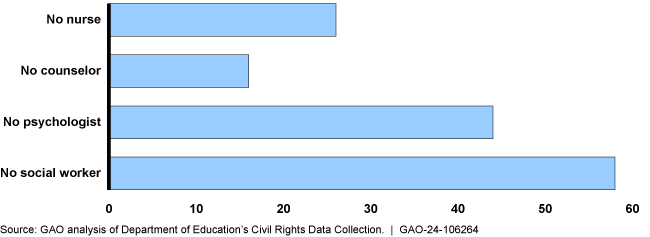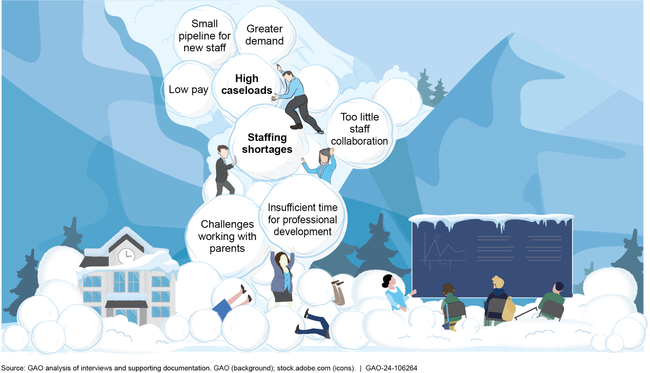Special Education: Education Needs School- and District-Level Data to Fully Assess Resources Available to Students with Disabilities
Fast Facts
Many children with disabilities are entitled to special education services tailored to their needs. But it seems that many schools don't have the resources or staff to meet those needs—e.g., social workers, school psychologists, and counselors—creating inequitable access to services.
The Department of Education can't address such inequities across schools and districts because it's only authorized to collect specific data at that level. Authority to collect data such as school or district staffing numbers and service hours could help solve this issue. We recommended that Congress consider allowing Education to collect more data.
Percentage of Public School Students with Disabilities Who Attended a School Without Key Personnel, School Year 2020-2021

Highlights
What GAO Found
All 32 entities GAO visited—including 16 school districts, four state educational agencies, and 12 special education organizations across four states—said personnel shortages were a key obstacle to educating students with disabilities. This is consistent with GAO's 2022 work on teacher shortages, which showed a nationwide shortage of special education teachers. Other obstacles cited by officials in most districts were insufficient time for professional development, challenges communicating with parents, and insufficient collaboration between general and special education staff. The snowball effect of these obstacles may result in some students not receiving needed education and services (see figure). Officials said some students do not receive high-quality education, some receive delayed services, and some do not receive services at all. State and school district officials described strategies to mitigate these obstacles, including mentorship programs and ways to grow the teacher pipeline.
Snowball Effect of Reported Obstacles to Educating Students with Disabilities

Department of Education data showed that many students with disabilities attend schools without key personnel. In the 2021–22 school year, just 20 percent of public-school students with disabilities attended a school having a social worker, school psychologist, school nurse, and counselor. GAO also found variation across states in student with disabilities-to-staff ratios (ranging from 9 to 1 in one state to 30 to 1 in another). Although research suggests that resources are often distributed unequally across schools within districts, most data—such as the number of certain special education staff—are not available at the school level. These data gaps hinder Education's ability to assess the distribution of resources in its efforts to address a stated purpose of IDEA. Education officials told GAO that, in general, they do not have the statutory authority to collect such data. By granting Education authority to collect school- and district-level data, Congress could enable Education to better assess how special education resources are distributed at these levels, and why any disparities exist.
Why GAO Did This Study
During school year 2021–22, around 7.3 million children ages 3 through 21 received special education and related services under the Individuals with Disabilities Education Act (IDEA). This act is the primary federal special education law for children and youth with disabilities. Last reauthorized in 2004, IDEA was enacted to ensure access to a free appropriate public education for all children with disabilities. One of IDEA's stated purposes is to assess, and ensure the effectiveness of, efforts to educate children with disabilities.
GAO was asked to review obstacles to providing special education and how the distribution of resources for educating students with disabilities varies across states and school districts. This report addresses obstacles to educating students with disabilities and efforts to mitigate those obstacles, as well the availability of resources for special education.
GAO visited states and school districts selected based on experts' recommendations of states with notable strategies for providing special education. GAO interviewed Education officials and analyzed the most recent available national data on special education resources and expenditures.
Recommendations
GAO is recommending that Congress consider granting Education authority to collect school- and district-level data, where feasible, on special education and related resources.
Matter for Congressional Consideration
| Matter | Status | Comments |
|---|---|---|
Congress should consider granting Education authority under IDEA to collect school- and district-level data on special education and related resources, where feasible, that would help Education fulfill its oversight responsibilities under the law. Such data could include
(Matter for Consideration 1) |
As of February 2025, there is no congressional activity on this matter. |
